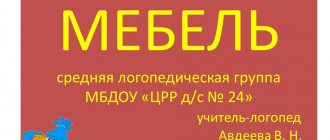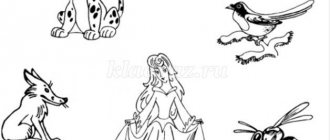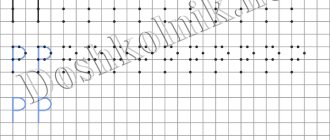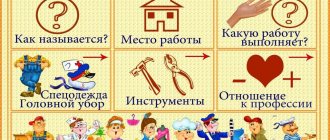On the topic: methodological developments, presentations and notes
Lesson on the topic “Word Composition”, aimed at consolidating students’ knowledge in analyzing words by composition. Designed for students with agrammatic dysgraphia.
Lesson on the topic: “Polysemantic words” introduces children to the concept of polysemy of words, clearly shows the existence of polysemantic words in different parts of speech.
This speech therapy lesson is designed for 3rd grade students with disabilities. Topic of the lesson: “Word composition” (general lesson). The purpose of the lesson is to consolidate children’s knowledge about the composition of words. To the lesson notes.
Lesson notes on the topic “Proposal” are intended for 3rd grade students.
The lesson notes were compiled for 3rd grade students (ZPR) on the topic “Polysemantic words.” The purpose of the lesson was to introduce children to polysemantic words through speech exercises and games.
summary of a speech therapy lesson in 4th grade “Words-objects”.
Consolidation of concepts about words denoting objects and actions, development of auditory attention, linear speech-auditory memory, verbal-logical thinking.
Progress of the lesson
1. Organizational moment.
- Hello, my name is Narmina Ikramzhonovna, we will do this lesson together .
2. Clarification of knowledge about speech, sentence , phrase , word . Report the topic of the lesson .
- Why does a person need speech? What kind of speech is there? (oral and written)
How does written language differ from spoken language?
- Everything you and I say is our speech. What does our speech consist of?
-A sentences (from words )
-What is a word (a unit of speech that is a sound expression of a separate subject of thought .)
If we say the word “book”
, do we understand what they wanted to say?
We named the object , but didn’t say anything about it. And here it is: “big book”
.
This is what the attribute of an object . And here it is: “The big book is on the table
.
Has it become clear? What did I say? (
sentence ) -Listen to what I tell you: chair, sit down. Is that what we say? Of course not. This means that our speech consists of sentences and phrases , and they, in turn, are made of words .
-Based on this, you can formulate the topic of today’s lesson . ( phrase and sentence )
3. Introduction to the topic. Explanation of new material.
Analysis of the proverb .
-Read the sentence . (A sandpiper flew from overseas and brought spring from captivity.)
- What is it ( proverb )
-How do you understand it (children’s statements)
A sandpiper flew from overseas and brought spring from captivity.
-Who is the proverb about ?
-Who is this sandpiper? (Kulik is a small wading bird with long legs)
-Why did he come from overseas?
-Explain what “Brought spring from captivity”
?
-Who is the sentence ? (about the sandpiper)
-What did he do (fly and bring)
-What are they? (main members of the sentence )
-Are they a phrase ?
- They cannot be a phrase .
-To find a phrase , we first take the subject. We ask him a question that matches the meaning of the words . Which word is the subject here (sandpiper)
-Can we get away from him?
- If the question is not asked from the subject, then we ask from the predicate?
-Which words are predicates ? (flew and brought)
We take 1 predicate and ask a question.
What question? (flew (from where)
from overseas) Take the 2nd predicate.
He brought (what)
spring, spring
(how)
from captivity.
-What will it be? ( collocation )
-What does a proverb (from words and phrases )
-So, we make phrases from words . And from the phrase ? ( Offers .)
A phrase is two or more words that are grammatically related. In a phrase, one word is main and the other is dependent. ( A question is asked from the main word .)
The combination of subject and predicate
(grammatical basis
of a sentence ) is not
a phrase .
To find phrases in a sentence , you need to move from one word to another so that the meaning is preserved.
-What is a sentence ( a word or combination of words that expresses a complete thought (gram.)
.)
-I have prepared more proposals
— Read the sentence “In spring, migratory birds sing merrily in gardens and parks”
.
-Who is the sentence (birds)
-What are they doing? (singing)
-What is this? These are the main members of the sentence .
-Are they a phrase ?
- They cannot be a phrase .
-To find a phrase , we first take the subject. We ask him a question that matches the meaning of the words . Which word is the subject here (birds)
-Which word should we ask a question and what question? (birds (what)
migratory)
-What will it be? ( collocation )
-Can I ask another question? (No)
If the question is not asked from the subject, then we ask from the predicate?
-Which word is the predicate ? (singing)
Sing (where)
in gardens and parks.
Sing (when)
in the spring.
Sing (like)
funny.
-Is this what you and I wrote out? ( collocations )
4. Finger gymnastics
Alternately connect the pad of each finger with the thumb, forming a ring. First on the right, then on the left. And at the end of the lesson - synchronized movements on both hands.
One two three four five,
The fingers went out for a walk.
One two three four five,
Let's count fingers.
Close the big, middle and ring fingers into a ring. Stretch the rest to the sides as much as possible (make a goat)
.
After this, close the thumb, ring finger and little finger into a ring (make “horns”
). Repeat these shapes 3 times with each hand.
Three positions on the table plane. Fist, then palm edge-on on the table, palm straight on the table. Do it with your right hand, left hand, then synchronously.
Hook your middle finger over your index finger - a cross. Then connect the pads of the index finger and thumb - a zero. Alternate these movements.
5. Consolidation of what has been learned.
Work in notebooks.
Game “ Highlight the phrases ”
-Read the sentence , name the phrases
1. In spring, rooks build nests. (view (who? what)
nests made
(when)
in spring)
2. The spring sun is shining brightly. (shines (like)
bright, sun
(what)
spring)
3. The gentle sun looked in through the open window. (sun (what)
affectionate, looked
(where)
into the window, the window
(which)
is open)
4. Spring pleases with ringing drops and bright sun. (pleases (with)
drops and the sun, drops
(so)
sonorous, sun
(so)
bright)
5. The breeze moves through the colorful foliage. (looks over (who? what)
foliage, foliage
(what)
variegated)
6. The boy lived in a small village on the shore of a forest lake. (lived (where)
in a village, on the shore, in a small village
,
on the shore
of
a lake,
a
forest lake)
7. The cry of the cuckoo came from the nearby forest. (cry (of whom)
cuckoo, came from
(from)
the forest, the forest
(what)
neighbor).
8. The trees dropped their autumn attire. (dropped (who? what)
outfit, outfit
(what)
autumn, outfit
(whose)
yours).
9. The willow showered the Christmas tree with thin golden leaves.
-What is written down? (spring streams, running through the streets of the city, running through the streets, running merrily)
-What can you do with them? ( offers )
-Make sentences . Write it down with commentary.
-Write down a phrase with questions .
-What is a phrase ? What is not a phrase ?
- What did we talk about in today's lesson ?
DOWNLOAD PRESENTATION
Developed by a teacher-speech therapistVasilyeva Elvira Gennadievna
Cheboksary special (correctional) primary school-kindergarten No. 3 “Nadezhda” of the Chuvash Republic
slide 1
Goal: developing ideas about the content side of sentences to ensure its semantic completeness and communicative expediency
Tasks:
Educational:
1) developing the ability to determine the number and sequence of words in a sentence;
2) consolidation of the skill of grammatical formatting of sentences, coordination of words in a sentence;
3) differentiation of prepositions and prefixes,
Corrective:
4) development of logical thinking, memory, attention;
5) correction of fine and gross motor skills
Educational:
- developing a sense of responsibility and self-confidence;
- formation of personal qualities;
- cultivating a sense of respect for adults, the ability to communicate with teachers and children in a team
Equipment: screen, projector, computer, task cards, notebooks
Progress of the lesson
- Organizing time.
1. Development of visual perception and visual gnosis.
Speech therapist: Guys, what objects are shown on the slide? (frog, reeds, dragonfly - overlaid images) What are words made of? (from syllables)
How many syllables are in each of these words? (3)
slide 2
- Making proposals based on guessed pictures.
Speech therapist: What is a sentence? (words related to each other in meaning)
Make up a sentence with words - names of pictures. (The frog sat in the reeds and looked at the dragonfly.)
Speech therapist: How many words are there in your sentence?
- Formulating the topic of the lesson.
Speech therapist: Who guessed what we will do in class? (work with suggestions)
- Main part
1. Meet the hero.
Speech therapist: We received a mysterious letter. Review the recording. Try to decipher this letter and read it, then you will find out who wrote it. (There is a note on the cards, words in brackets are replaced with pictures)
Text of the letter: I have a (barrel) of honey. There is also a (jar) of jam. I will soon (come) to visit you and bring you a treat. (Winnie the Pooh)
slide 3
- Restoring deformed sentences.
Speech therapist: Winnie the Pooh loves honey very much, but the bees don’t let him get enough of it. Let's help Winnie the Pooh.
slide 4
Speech therapist: Make up sentences from the words the bees brought. Write down the resulting sentences.
Words: - it was summer, sultry (It was sultry summer.)
- jackdaw, on, fence, sat down (A jackdaw sat down on the fence.)
- Kolya, I asked a riddle (Kolya asked a riddle.)
- cat, attic, on, climbed (The cat climbed into the attic.)
- in, flooded, yard, skating rink, big, flooded (In the yard, the children flooded a large skating rink.)
Physical exercise for the eyes ( Masko ophthalmic simulator)
slide 5
- Establishing logical connections between words within sentences.
Speech therapist: Do you know Winnie the Pooh’s friends? (Piglet, Tigger, Eeyore, etc.)
slide 6
Tigger got naughty and rearranged the words in the sentences. Let's together correct logical errors and write the sentences correctly.
slide 7
— In the spring, the meadows flooded the river.
— The goat gave the girl water to drink.
— After summer, the long-awaited spring came.
Speech therapist: Tigger is pleased with your help. He will definitely tell Piglet about this.
slide 8
But suddenly impudent and hungry crows flew at Piglet.
Speech therapist: How to drive them away? (put up a scarecrow, shoot with a slingshot). Yes. But there is another method - birds do not like to exercise. Let's all start doing exercises together with Piglet, Tigger and Winnie the Pooh - the crows will immediately fly away.
slide 9
Physical exercise (with movements)
- Differentiation of prepositions and prefixes in sentences. Strengthening the skill of agreeing words in a sentence.
Speech therapist: The friends were having so much fun that they didn’t notice Eeyore. He is upset: the crows took some words with them. Eeyore just can't cope.
Speech therapist: Let's help the donkey Eeyore: complete the sentences by inserting words that suit their meaning. Think about how to correctly write small words in brackets - together or separately? What is the difference between a preposition and a prefix? (you can insert another word between the preposition and the word). Let's underline the spelling.
slide 10
________ (boy) ran (along) the garden path
_________ (from) swam (from) the shore. (Boat)
Zhenya _________ (on) wrote (on) the address on the envelope. (Petrov)
5. Training in determining the boundaries of sentences.
Speech therapist: While we were choosing words, a wise owl appeared in the clearing. She brought a letter from Christopher Robin .
slide 11
Speech therapist: The owl wrote down everything that the boy wanted to convey to his friends. See why it is difficult to read a letter? What did the owl forget? (put punctuation marks). When should you put a period at the end of a sentence? (when the thought is over)
Speech therapist: Let's correct the mistakes made by the owl. Read and write the text correctly.
Text of the letter:
A fresh breeze blew, the sun rose, the birds sang loudly, who is it that is pouring in the raspberry bushes, how the dew drops glisten, how beautiful the forest is at dawn.
slide 12
Speech therapist: What sentences are found in the text regarding the purpose of the statement? What punctuation did you use? (?, !, .)
Speech therapist: Read the fifth sentence with Eeyore, the first sentence with Winnie the Pooh, and the last sentence from Christopher Robin’s letter with Tigger.
- Summarizing. slide 13
Speech therapist: What is a sentence? Text?
What was difficult in the lesson and what was easy?





